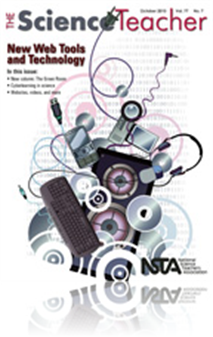All The Science Teacher resources
Journal Article
The Green Room: The Green Chemistry Laboratory
When it comes to making chemistry labs greener, there are two overarching goals: to reduce the consumption of energy and resources and reduce the production of hazardous and nonhazardous waste. Clearly, these two goals are inextricably linked. What i...
Journal Article
Model-Based Inquiry (MBI) is an emergent instructional strategy that is gaining acceptance among science educators. This approach to learning realistically mirrors the work of scientists, who develop and test hypotheses to construct more sophisticate...
Journal Article
Since 2008, several digital cameras have offered high-speed movie settings that allow video to be captured at 120 to 1,000 frames per second. That means you can play back a 1-second, real-time event in slow motion that spans 5, 10, 24, or even 40 sec...
Journal Article
This summer, the environmental disaster in the Gulf of Mexico unfolded with more drama than a summer blockbuster. America was riveted by a deadly explosion, a seemingly unstoppable geyser of toxic petroleum, beach cleaners in hazmat suits, and the me...
Journal Article
Editor’s Corner: Inquiring Minds
Regular readers of The Science Teacher (TST) may have noticed a lot of articles on scientific inquiry and notable among TST articles on inquiry are Bell and colleagues' “Simplifying Inquiry Instruction” and McComas’s “Laboratory Instruction i...
Journal Article
In the lesson presented in this article, students learn to organize their thinking and design their own inquiry experiments through careful observation of an object, situation, or event. They then conduct these experiments and report their findings i...
Journal Article
One way to advance inquiry in the classroom is to establish a systematic strategy for reflecting on our practice and our students’ readiness to engage in increasingly complex scientific reasoning. The Matrix for Assessing and Planning Scientific In...
Journal Article
Exploring Osmosis and Diffusion in Cells
Guided inquiry is an instructional technique that requires students to answer a teacher-proposed research question, design an investigation, collect and analyze data, and then develop a conclusion (Bell, Smetana, and Binns 2005; NRC 2000). In this ar...
Journal Article
Science Pipes: A World of Data at Your Fingertips
A new online tool called Science Pipes allows students to conduct biodiversity investigations. With this free tool, students create and run analyses that would otherwise require access to unwieldy data sets and the ability to write computer code. Usi...
Journal Article
Career of the Month: An Interview With Medical Physicist John Winston
You have probably heard that radiation is used to combat cancer, but might be wondering how exactly this works. X-rays deposit a specified dose of high energy into the cancerous tissue. This damages the cancer cells’ DNA beyond repair, causing the ...
Journal Article
Self-regulated learning (SRL) encourages students to learn using metacognition, strategic action, and motivation. This nontraditional approach to education relies on the student’s active role in learning and the instructor’s facilitatory role in ...
Journal Article
For this issue’s “New Web Tools and Technology” theme, the authors thought it appropriate to showcase one innovative web project in depth. Ben Wildeboer, a science teacher in Connecticut, agreed to talk with them about student blogging and his ...
Journal Article
Editor’s Corner: New Tools for Learning
Technology has the potential to transform science education through online social network collaboration, satellite navigation and imaging, field and laboratory digital probeware, wikis and blogs, sophisticated online data sets, student response syste...



